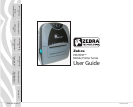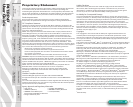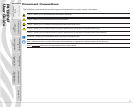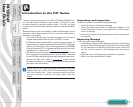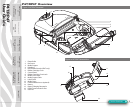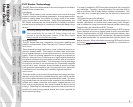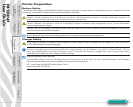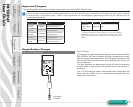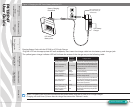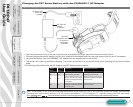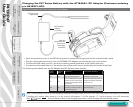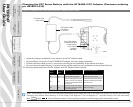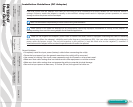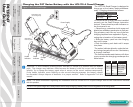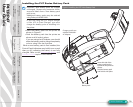
6
P4T/RP4T
User Guide
The P4T Series introduces several new technologies to the Zebra
Mobile Printer product line.
Smart Battery
The P4T Series battery pack contains electronics which allow the
printer to monitor its operating parameters. Among these are the
battery’s charge state, the number of charge cycles it has under-
gone, and its date of manufacture. Using these parameters, the
P4T Series’ software can monitor the battery’s condition and alert
the user when to recharge, re-condition or remove the battery from
service.
Use of any battery pack other than the one manufactured by
Zebra specifically for use with P4T Series printers will not
be able to use the diagnostic features of the Zebra Smart
Battery and will not work with the printer.
Printing Technology
The P4T Series uses two methods to print human readible text,
graphics and barcodes: Direct Thermal, and Thermal Transfer
Direct Thermal
Direct thermal printing uses heat to cause a chemical reaction on
specially treated media. This reaction creates a dark mark wher-
ever a heated element on the printhead comes in contact with the
media. Since the printing elements are arranged very densely at
203 d.p.i. (dots per inch) or 8 dots per mm, highly legible characters
and graphic elements may be created a row at a time as the media
is advanced past the printhead. This technology has the advantage
of simplicity, as there is no requirement for consumable supplies
such as ink or toner. However, since the media is sensitive to heat,
it will gradually loose legibility over long periods of time, especially
if exposed to environments with relatively high temperatures.
Thermal Transfer
Thermal transfer printing uses the same basic technology as direct
thermal, except that the printhead elements react with a transfer
film which passes between the printhead and the media. The print-
ing process fuses the thermal transfer material to the media being
printed and creates characters and graphic images that are very
dark, and more permanent than those created by direct thermal
printing. Offsetting this advantage is the extra cost of the thermal
transfer film and printing speeds slower than those required for
direct thermal printing.
For ease of installation, P4T Series thermal transfer film is supplied
as a cartridge. Typically a thermal transfer film cartridge will be
able to print two rolls of media before needing replacement. This
ratio may vary considerably based on the amount of label stock
per roll.
RFID (Radio Frequency Identication)
A P4T Series printer equipped with an RFID encoder allows it to
encode information on special label media using radio frequen-
cies in addition to using conventional thermal transfer technology.
These printers are identified as RP4T printers.
RFID encoded information can be retrieved using an RFID scanner
from a distance of inches to several yards from an encoded label.
Zebra’s implementation of RFID follows accepted industry stan-
dards. As an example, the RP4T verifies the information encoded
on the label media after it is transmitted and voids the label if the
data is incorrect. More information concerning RFID may be found
in Zebra’s RFID Programming Manual, available for download on
Zebra’s Web site.
P4T Series Technology
Printer Preparation
pg. 7
Connecting the
Printer pg. 27
Radio Regulatory
Information pg. 31
RP4T Printers pg.
35
Maintenance pg. 36
Troubleshooting pg.
38
Specications pg.
43
Appendices pg. 46 Index pg. 52
P4T Overview-
pg. 5
Manual
Introduction pg. 4



